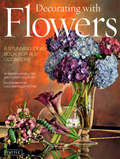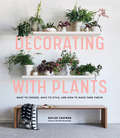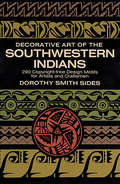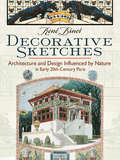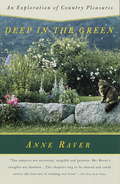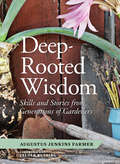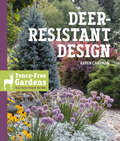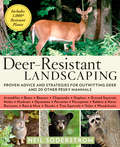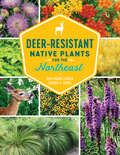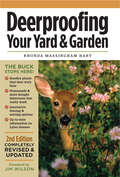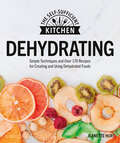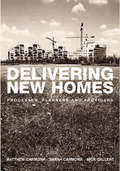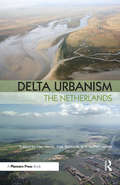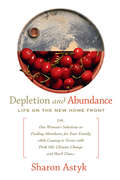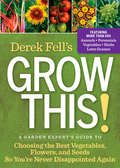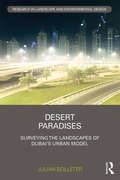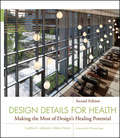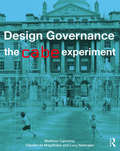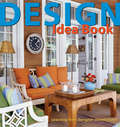- Table View
- List View
Decorating with Flowers
by Elizabeth Reyes Luca Invernizzi Tettoni Roberto CaballeroUse fresh flowers to make a dramatic difference in your home...and dazzle with the power of flowers when you entertain! Decorating with Flowers celebrates the latest trends in contemporary floral design with a tropical twist. Featuring inspired table settings and installations, this extraordinary book will encourage you to create your own unforgettable floral creations every time you entertain!The ten designers and artists showcased share the ideas and insights behind their creations--each of which is shown in detailed photos--making this an excellent guide for interior decorators, florists, event planners and homeowners looking to add some pizzaz to a space.Featuring over 300 color photographs, Decorating with Flowers has something for everyone-from glamorous Flemish floral arrangements to modern Sogetsu ikebana styles, and modular flower sculptures created to enhance minimalist, contemporary spaces.
Decorating with Plants: What to Choose, Ways to Style, and How to Make Them Thrive
by Baylor ChapmanHouseplants are more popular than ever before—especially with millennials, who are setting up their homes for the first time and discovering that nothing can add energy, style, and that essential “lived-in-ness” to their spaces better than a little bit of green. Whether it’s a statement-making fiddle-leaf fig or a tiny tabletop succulent, a houseplant instantly elevates the look of your home. But where to begin? In Decorating with Plants, Baylor Chapman walks readers through everything they need to know to bring houseplants into their home. First, there’s Plant Care 101: from how to assess light conditions to tricks for keeping your plants alive while on vacation, Chapman gives readers the simple, foundational info they need to ensure their plants will thrive. Then she introduces us to 28 of her favorites—specimens that are tough as nails but oh-so-stylish, from the eye-catching Rubber Tree to the delicate Cape Primrose. Finally, she guides readers through the home room by room: Place an aromatic plant like jasmine or gardenia to your entry to establish your home’s “signature scent.” Add a proper sense of scale to your living room with a ceiling-grazing palm. Create a living centerpiece of jewel-toned succulents for a dining table arrangement that will last long after your dinner party. From air purification to pest control, there’s no limit to what houseplants can do for your home—and Decorating with Plants is here to show you how to add them to spaces big and small with style.
Decorative Art of the Southwestern Indians
by Dorothy S. SidesThe decorative art of the Indians of the American Southwest has long been recognized as one of the most beautiful art traditions in the primitive world. It demonstrates a technical skill with simple materials, a symbolic richness, and a faculty for creating rich effects by the imaginative use of ornament that are all almost unique. Museums use Pueblo ceramics for display pieces, and modern artists and crafters have turned eagerly to the handwork of prehistoric Indian women for inspiration and working ideas.Mrs. Dorothy Sides, a noted artist and collector, has gathered together and redrawn in black and white nearly 300 examples of the finest authentic Southwestern Indian decoration that she has seen in a lifetime of study. She has not limited her selection to one period or style, however; to make her book as useful as possible, she has selected material ranging from the thirteenth century great geometric art of the Pueblos to the handcrafts carried on by the nomadic and Pueblo peoples of the present.The main emphasis of this volume is on ceramic decoration, and Mrs. Sides includes pieces from the rich archeological sites of Pecos, Sikyatki, the Mimbres, and modern Pueblo pottery from Acoma, Zuni, Cochiti, and the Hopi. She also includes designs and motifs from the basketry of the Apache, Pima, and Papago; beadwork from the Mohave; authentic Zuni masks; Hopi kachina dolls; and sand paintings and blanket designs from the Navajo. This broad coverage of beautiful ornament illustrates many different art styles to fit every situation: geometric designs based upon balanced mirror fields of design, symbolic figures of the thunderbird, and modern stylizations. All is beautiful and imaginative.Any crafter working with ceramics will find this book indispensable as a source of rich, easily used, powerful design; workers in wood, weavers, metal workers, and leather workers will find that it will enlarge their decorative resources considerably. It also offers unusual and eye-catching designs for commercial artists who wish to do work suggesting travel, handcrafts, the Southwest, or the social sciences. Individual drawings are royalty-free and may be reproduced without fee or permission.
Decorative Sketches: Architecture and Design Influenced by Nature in Early 20th-Century Paris
by René BinetAt the turn of the 20th century, artists and craftsmen throughout Europe and America were profoundly affected by a new art style that took its inspiration from nature. Generally referred to as Art Nouveau, the trend influenced all manner of creative types, from painters, illustrators, and architects to ironworkers, interior decorators, and designers of furniture and jewelry. Although broad and varied, the style is almost uniformly characterized by abstract, asymmetrical, curvilinear design. This "new art" both elevated the status of crafts to fine arts and brought objects into a harmonious relationship with their environment through the use of lines that were natural, vital, and, most importantly, organic.The decorative images in this volume, reproduced from a rare 1902 portfolio, reflect the era's exotic and imaginative approach to architecture and applied design. Sixty plates, 12 in full color and many with partial and varied color, exhibit the influence of the artwork of naturalist Ernst Haeckel on artist René Binet's designs, especially as related to Binet's "Monumental Door," prepared for the 1900 World's Fair in Paris. Illustrations reflecting the styles of Art Nouveau include a wealth of examples that range from doorbells and keys to stairways, fountains, jewelry, ceramics, and other items. Graphic designers, illustrators, architects, artists, and crafters will find this volume a rich source of ornamental ideas, authentic motifs, and design inspiration.
Deep in the Green
by Anne RaverAs gardening columnist for The New York Times, Anne Raver is one of our foremost authorities on making things grow. Even non-gardeners will find this book of essays a source of profound pleasure, for Raver is a writer who transcends her subject even as she illuminates it, writing with such passion, wisdom and stylishmess that her book will enchant anyone who reads it.
Deep-Rooted Wisdom: Skills and Stories from Generations of Gardeners
by Augustus Jenkins FarmerWe have begun to lose some of the most important skills used by everyday gardeners to create beautiful, productive gardens. With a personality-driven, engaging narrative, Deep Rooted Wisdom teaches accessible, commonsense skills to a new generation of gardeners. Soulful gardener, Augustus Jenkins Farmer, profiles experienced and up-and-coming gardeners who use these skills in their own gardens. Enjoy this chance to get planting, propagation, and fertilizing knowledge handed down directly from the experts in the field.
Deer-Resistant Design: Fence-free Gardens that Thrive Despite the Deer
by Karen Chapman“Fear deer no more! The best source I’ve seen on the topic!” —Tracy DiSabato-Aust, award-winning garden designer and best-selling author Deer are one of the most common problems a gardener can face. These cute but pesky animals can quickly devour hundreds of dollars’ worth of plants. Common solutions include the use of unattractive fencing and chemicals. In Deer-Resistant Design, Karen Chapman offers another option—intentional design choices that result in beautiful gardens that coexist with wildlife. Deer-Resistant Design showcases real home gardens across North America—from a country garden in New Jersey to a hilltop hacienda in Texas—that have successfully managed the presence of deer. Each homeowner also shares their top ten deer-resistant plants, all welcome additions to a deer-challenged gardeners shopping list. A chapter on deer-resistant container gardens provides suggestions for making colorful, captivating, and imaginative containers. Lushly illustrated and filled with practical advice and inspiring design ideas, Deer-Resistant Design is for every gardener looking for artistic solutions to this challenging problem.
Deer-Resistant Landscaping: Proven Advice and Strategies for Outwitting Deer and 20 Other Pesky Mammals
by Neil SoderstromEvery year, before they decide to take defensive action, vulnerable homeowners throughout North America suffer expensive damage as deer and various other pesky mammals devour their gardens and landscape plants. Deer-Resistant Landscaping by Neil Soderstrom arms homeowners with the proven strategies they need to repel and combat deer and 21 other troubling pests, from armadillos, chipmunks, and gophers to rabbits, raccoons, skunks, and squirrels. Outstanding features include: • strategies for every season and every size pest—from simple, low-cost home remedies, scare tactics, and deterrents to live trapping, barriers, and community action procedures suitable for more intense problems • interviews with and tips from regional gardening and wildlife control experts from coast to coast • encyclopedic coverage of more than 1,000 resistant plants—especially those least likely to be grazed upon or destroyed by deer, based on scientific studies and a consensus of gardening authorities throughout the continent • stunning full-color wildlife photography featuring deer and pest behaviors as well as solutions and deterrents With more than 400 of the author's own gorgeous wildlife photos as well as ones by the legendary naturalist Dr. Leonard Lee Rue III, the most published wildlife photographer in North America, Deer-Resistant Landscaping provides the most wide-ranging, authoritative, and helpful information on this topic ever assembled in one volume.
Deer-Resistant Native Plants for the Northeast
by Ruth Rogers Clausen Gregory D TepperFill your garden with native plants, not deer The benefits of growing natives are plentiful—less upkeep, more pollinators, and a better environment. In Deer-Resistant Native Plants for the Northeast, Ruth Rogers Clausen and Gregory D. Tepper provide a list of natives that have one more benefit—they are proven to help prevent your garden from becoming a deer buffet. From annuals and perennials to grasses and shrubs, every suggested plant includes a deer-resistance rating, growing advice, companion species, and the beneficial wildlife the plant does attract. Let these beautiful natives help your landscape flourish! For gardeners in Connecticut, Delaware, Maine, Maryland, Massachusetts, New Hampshire, New Jersey, New York, North Carolina, Pennsylvania, Rhode Island, Vermont, Virginia, West Virginia, and Washington, DC.
Deerproofing Your Yard & Garden
by Rhonda Massingham HartFrom nibbling on fruit bushes to destroying flower beds, unwanted deer pose a frustrating and challenging obstacle to even the most patient gardeners. Rhonda Massingham Hart provides insights into deer behavior and offers a variety of proven techniques to keep your deer problem under control. Learn how to choose the best fence types, landscape with plants deer detest, make effective homemade repellents, and much more. You’ll have all the information you need to maintain a pristine, deer-free landscape.
Defend your house from the risk of flooding - Do it yourself: your own bulkhead against flooding
by Silvia Dalla Zanna Pasquale PizzichettiSome say that the danger posed by water is worse than that of fire. In effect I fear both. However, either if you live in a city or in a provincial town, there is always a risk, higher or lower, to be flooded by water. For those who do not want to suffer passively the events, here is a practical guide to build "Do it yourself" bulkheads against flooding. With some good will and time, you can build a low cost efficient system with simple materials. This guide is intended for everybody, but in particular for people who are not professional in this field.
Dehydrating: Simple Techniques and Over 170 Recipes for Creating and Using Dehydrated Foods (The Self-Sufficient Kitchen)
by Jeanette HurtPerfectly preserve your favorite foodsDehydrating is easy and inexpensive, and the results are loaded with flavor and nutrition. If you have a bumper crop of garden vegetables, scored a deal on in-season fruit at the farmer's market, or have a neighbor with more fresh oregano than they know what to do with, there's no better way to preserve your bounty than by dehydrating! With over 170 recipes for dehydrating fruits, vegetables, jerkies, leathers, trail mix, and even treats for your dog, this definitive guide gives you everything you need to know to make the most of your dehydrator. In this newly updated edition, you'll discover:A guide on the types of dehydrators availablePointers on proper food prep and safety storageDozens of recipes on dehydrating all kinds of fruits, vegetables, and herbsRich and flavorful recipes for dehydrated beef, chicken, duck, and other jerkiesEasy ideas for making chips, granola, croutons, and more with your dehydratorSatisfying meringues, cookies, and other desserts to satisfy any sweet tooth
Delish Kids (Super-Awesome, Crazy-Fun, Best-Ever) Cookbook Free 12-Recipe Sampler
by Joanna SaltzA special sampling of 12 recipes for amazing lunches from The Delish Kids (Super-Awesome, Crazy-Fun, Best-Ever) Cookbook include Waffle Iron Grilled Cheese, Hot Dog Cubanos, Summer Rolls and Taco Mac & Cheese!Inside, you&’ll find: • A color photograph for every recipe • Equipment lists and easy-to-follow instructions for each recipe • PLUS: Fun Things to Make With Chicken Nuggets and How to Build a Grain BowlOnce you&’ve tried these recipes you&’ll want to get all 100 of them in The Delish Kids (Super-Awesome, Crazy-Fun, Best-Ever) Cookbook! Go from apprentice to pro with 100+ recipes for every meal and skill level, including restaurant copycats and foods inspired by your favorite pop culture characters. Order now!
Delish The How-To Cookbook for Young Foodies: 75 Skills + Recipes That'll Make You a Great Cook for Life
by Joanna SaltzBoost your budding foodie&’s kitchen confidence with this beginner-friendly Delish cookbook featuring easy-to-follow recipes and instructions for kids ages 8 to 12Follow step-by-step photos and complete each task to learn 25 essential cooking techniques, 50 delicious recipes, and fun food facts!Any kid can be a great cook, it just takes some practice! Follow the editors of Delish on an epic cooking quest to learn all the basics and have tons of fun along the way. In this gamified cookbook, step-by-step photos and clear instructions present essential know-how so young chefs can follow along as they learn cooking basics.Organized from simple techniques to more complex ones, kids will amp up their cooking skills as they progress through the book and put their new skills to practice with amazing and inventive recipes such as Mac & Cheese Pizza Bites and Sugar Cookie Fries. Inside young foodies will discover: How to slice vegetables and make Greek Salad (Horiatiki) and Cucumber Sushi The best way to prep citrus and how to whip up GranitaThe secrets to whisking and then using that skill to make Birthday Cake DipHow to knead dough for the best-ever Calzones and Cinnamon Sugar Pretzel NuggetsAnd so much more! Plus, crave-worthy color photos, helpful tips, and cool food facts will encourage kids to cook through every page making this the ultimate gift for your budding chef.
Delivering New Homes: Planning, Processes and Providers
by Nick Gallent Sarah CarmonaThis book examines the processes and relationships that underpin the delivery of new homes across the United Kingdom, focussing primarily on the land use planning system in England, the way that housing providers engage with that system, and how the processes of engagement are changing or might change in the future. Planning, market and social house building - the three key processes - are first dissected and explored individually, then brought together to study the key areas of interaction between planning and the providers of social and market housing by way of the range of tensions that have consistently dogged those interactions. Extensive illustrative case study material provides a platform to the consideration of developing more integrated, realistic and proactive approaches to planning.Proposing evolutionary, and sometimes radical proposals for change, Delivering New Homes makes a bold contribution to finding a better way of delivering the new homes that the nation increasingly needs.
Delta Urbanism: The Netherlands
by Han Meyer Steffen Nijhuis Inge BobbinkDelta Urbanism is a major new initiative that explores the growth, development, and management of deltaic cities and regions, with the aim of balancing various goals in a sustainable manner: urbanization, port commerce, industrial development, flood defense, public safety, ecological balance, tourism, and recreation. This book is a detailed history and overview of how one low-lying country has developed the policies, tools, technology, planning, public outreach, and international cooperation needed to save their populated deltas.
Depletion and Abundance
by Sharon AstykWhy are so few peak oil authors women? There's been much debate about this, and no one has yet arrived at a definitive answer. But whatever the reason, Sharon Astyk has established herself as a true rarity within the peak oil community by virtue of being a woman who has chosen to write about peak oil. The perspective she offers is thus both uncommon and vital.In Depletion and Abundance, she shows how rewarding life on her New Home Front could be, immeasureably improving our health, nutrition, sense of community and overall well-being. Chief among its benefits would be all the extra time that we'd have. She points out that people in medieval times worked far fewer hours than Americans do today, and that most people in modern-day peasant societies also work less hard than we do.This, along with Astyk's unique perspective as a woman, a mother and a peak oil activist, makes Depleiton and Abundance well worth a read. The ring of authenticity to her writing will hook you - while its relaxed style, ineffable humor, personal anecdotes and comforting touch will soothe your melancholy peaknik soul like a warm hand on the shoulder.Reviewed by Frank Kaminski, Energy BulletinSharon's introduction is pricelss in its succinct, dead-on analysis of collapse, and is reason enough to buy and send this book to everyone you know who is partially or completely clueless about where we're headed. "When I realized that everything was going to change, I was at first afraid. Because I thought, if my government or public policy or other choices weren't going to fix everything, what could I possibly do? What hope was there, if I had to take care of myself, if my community had to take care of itself?But when I began looking for solutions that could be applied on the level of ordinary human lives, that involved changes in perspectives and pulling together, the reclamation of abandoned ideas and the restoration of strong communitites, I began to feel hopeful, even excited. Because I realized that when large institutions cease to be powerful, sometimes that means that people start being powerful again."Depletion and Abundance is not a feel-good book, but it is intensely human, compassionate, supportive, pracitcal, alarming, enlivening, and astonishingly accurate.Reviewed by Carolyn Baker, Carolynbaker.netClimate change, peak oil, and economic instability aren't just future social problems-they jeopardize our homes and families right now.Our once-abundant food supply is being threatened by toxic chemical agriculture, rising food prices and crop shortages brought on by climate change. Funding for education and health care is strained to the limit, and safe and affordable housing is disappearing.Depletion and Abundance explains how we are living beyond our means with or without a peak oil/climate change crisis and that, either way, we must learn to place our families and local communities at the center of our thinking once again. The author presents strategies to create stronger homes, better health and a richer family life and to:*live comfortably with an uncertain energy supply *prepare children for a hotter, lower energy, less secure world *survive and thrive in an economy in crisis, and *maintain a kitchen garden to supply basic food needs.Most importantly, readers will discover that depletion can lead to abundance, and the anxiety of these uncertain times can be turned into a gift of hope and action.An unusual family perspective on the topic, this book will appeal to all those interested in securing a future for their children and grandchildren.
Derek Fell's Grow This!: A Garden Expert's Guide to Choosing the Best Vegetables, Flowers, and Seeds So You're Never Disappointed Again
by Derek FellWhat gardeners want most is a bigger and better return on their investment of time and money—maximum yields and superior flavor for edibles, long-lasting blooms for flowers. Derek Fell's Grow This! features expert advice for choosing and growing the top-performing plants (and avoiding the ones that disappoint). Derek Fell has grown hundreds of varieties and annually visits gardens and test plots across America, so he's qualified to guide gardeners to the best of the best—more than 600 vegetable, flower, herb, and lawn grass all-stars. He offers honest feedback about plant performance, even when it contradicts favorable public opinion or a grower's claims. Seed racks may be filled with ‘Kentucky Wonder' snap beans, but he dismisses that variety as too fibrous and needy and instead recommends ‘Blue Lake' beans for tenderness and high yields. Fell's firsthand experience means the difference between choosing plant winners and losers. Packed with insider evaluations from seedsmen, growers, and nursery retailers that readers won't find elsewhere, Derek Fell's Grow This! explains industry lingo and debunks marketing hype to help gardeners select the best-performing plants for all garden conditions and goals.
Desert Paradises: Surveying the Landscapes of Dubai’s Urban Model (Routledge Research in Landscape and Environmental Design)
by Julian BolleterDesert Paradises: Surveying the Landscapes of Dubai’s Urban Model explores how designed landscapes can play a vital role in constructing a city’s global image and legitimizing its socio-political hierarchy. Using the case study of Dubai, Bolleter explores how Dubai’s rulers employ a paradisiacal image of greening the desert, in part, as a tool for political legitimization. Bolleter also evaluates the designed landscapes of Dubai against the principles of the United Nations and the International Federation of Landscape Architects and argues that what is happening in Dubai represents a significant discrepancy between theory and practice. This book offers a new perspective on landscape design that has until now been unexplored. It would be beneficial to academics and students of geography, landscape architecture, urban design and urban planning – particularly those with an interest in Dubai or the many cities in the region that are experiencing Dubaiification.
Desert or Paradise
by Sepp HolzerSepp Holzer farms steep mountainsides in Austria 5,000 feet above sea level. His farm is an intricate network of terraces, raised beds, ponds, and waterways, well covered with productive fruit trees and other vegetation, in dramatic contrast to his neighbors' spruce monocultures. Fans of Sepp Holzer have come from all over the world to see the productivity of his farm, a veritable permaculture paradise. His first book,Sepp Holzer's Permaculture, offers a detailed guide to what Holzer has achieved on his farm. Many readers might have wondered-but how can we achieve this on a global scale? Luckily, his newest book,Desert or Paradise, examines Holzer's core philosophy for increasing food production, earth health, and reconnecting mankind with nature, applied to reforestation and water conservation across the world. Through years of consultation with other countries, Holzer has developed a core philosophy for reconnecting mankind with nature even in arid or otherwise "lost-cause" regions. He details a process he calls "Grundierung," a term from painting meaning "base coat," which goes into great detail the importance of water, andDesert or Paradiseoffers his concept and guide to construction of large water reservoirs in arid, rainfall-dependent regions with examples from Greece, Turkey, Spain, and Portugal. Holzer describes the ecological and economic benefits of these changes, as well as the use of a variety of plant and animal species for further integration and regeneration of the surrounding areas, including reasons for reforestation and the cause and use of forest fires. Holzer also outlines his ten points of sustainable self-reliance and how these methods can help feed the world, such as the need to regulate the water budget, eliminate factory livestock farming, bring more fallow or unused areas into production, enlarge crop areas by using terracing and Holzer-style raised beds, regionalize instead of globalize, fight for land reform and engage in community building, go back to the ancient farming wisdom, and change the educational system. Also included are Holzer's ideas on beekeeping, humane slaughtering, nature spirits, the loss of roots in our society in general, and in politics especially.
Design Capital: The Hidden Value of Design in Infrastructure
by AnnaLisa Meyboom Sherry McKayWell-designed infrastructure brings social value that far exceeds its initial construction expenditure, but competition for scarce government funds and a general public perception of infrastructure as mere efficiency, has often left design ill-considered. This book provides designers with the tools needed to argue for the value of design: the ‘design capital’ as the authors term it. In naming and defining design capital, design can once again become part of the discussion and realization of every infrastructure project.Design Capital offers strategies and tools for justifying public spending on design considerations in infrastructure projects. Design has the ability to make infrastructure resonate with cultural or social value, as seen in the case studies, which bestows infrastructure with the potential to accrue design capital. Support for this proposition is drawn from various methodologies of economic valuation and Bourdieu’s theory of cultural capital, explanation of design methodology and education and a series of historical and contemporary case studies. The book also addresses some of the more controversial outcomes associated with contemporary infrastructure: gentrification, globalization and consumer tourism.With this book, designers can make a stronger case for the value of design in public infrastructure.
Design Details for Health
by Cynthia Leibrock Debra D. HarrisThe revised edition on implementing design details to improve today's health care facilities-an inspiring, comprehensive guide In this significantly revised second edition, Cynthia Leibrock and Debra Harris offer up-to-date information on design details that can improve patient outcomes and user experience by returning authority to the patient, along with fascinating case studies and research demonstrating the positive role design can play in reducing health care costs. Design Details for Health, Second Edition offers contemporary examples showing how design can improve patient comfort and independence, and demonstrates how to design highly functional health care facilities that operate at peak performance. The book addresses a range of health care facility types including hospitals, ambulatory care, wellness centers, subacute care and rehabilitation, adult day care and respite, assisted living, hospice, dementia care, and aging in place. This Second Edition includes: The latest research, which was only anecdotal in nature as recently as a decade ago, illustrating how design through evidence produces measurable outcomes Real-world case studies of a range of excellent health care facilities that have been designed and built in the twenty-first century Updated contributions with leading practitioners, researchers, and providers conveying how design has a positive impact on health care delivery When design empowers rather than disables, everybody wins. Sensitive to the needs of both patients and providers, Design Details for Health, Second Edition is essential reading for today's architects, interior designers, facility managers, and health care professionals.
Design First: Design-based Planning For Communities
by Linda Brown David WaltersWell-grounded in the history and theory of Anglo-American urbanism, this illustrated textbook sets out objectives, policies and design principles for planning new communities and redeveloping existing urban neighborhoods. Drawing from their extensive experience, the authors explain how better plans (and consequently better places) can be created by applying the three-dimensional principles of urban design and physical place-making to planning problems.Design First uses case studies from the authors’ own professional projects to demonstrate how theory can be turned into effective practice, using concepts of traditional urban form to resolve contemporary planning and design issues in American communities.The book is aimed at architects, planners, developers, planning commissioners, elected officials and citizens -- and, importantly, students of architecture and planning -- with the objective of reintegrating three-dimensional design firmly back into planning practice.
Design Governance: The CABE Experiment
by Matthew Carmona Claudio De Magalhaes Lucy NatarajanDesign Governance focuses on how we design the built environment where most of us live, work, and play and the role of government in that process. To do so, it draws on the experience of the Commission for Architecture and the Built Environment (CABE), a decade-long, globally unique experiment in the governance of design. This book theorises design governance as an arm and aspiration of the state; tells the story of CABE, warts and all, and what came before and after; unpacks CABE’s ‘informal’ toolbox: its methods and processes of design governance; and reflects on the effectiveness and legitimacy of design as a tool of modern-day government. The result is a new set of concepts through which to understand the governance of design as a distinct and important sub-field of urban design.
Design Idea Book: Learning From Designer Showhouses
by Karen TemplerLeading magazine editors team up with top builders and designers to provide fresh ideas that represent the best in modern home design, in a colorful volume that tours thirty-nine inspirational residences that combine real-world functionality with style to create designs that match today's busy family lifestyles.
